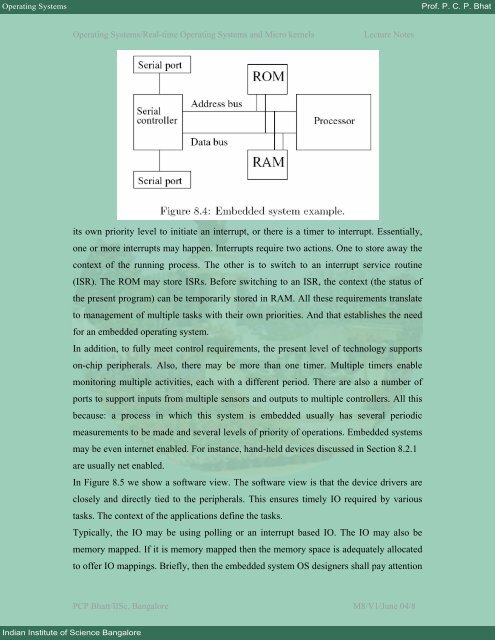Module 8: Real-time Operating Systems and Microkernels - E-Courses
Module 8: Real-time Operating Systems and Microkernels - E-Courses
Module 8: Real-time Operating Systems and Microkernels - E-Courses
You also want an ePaper? Increase the reach of your titles
YUMPU automatically turns print PDFs into web optimized ePapers that Google loves.
<strong>Operating</strong> <strong>Systems</strong> Prof. P. C. P. Bhat<br />
Indian Institute of Science Bangalore<br />
<strong>Operating</strong> <strong>Systems</strong>/<strong>Real</strong>-<strong>time</strong> <strong>Operating</strong> <strong>Systems</strong> <strong>and</strong> Micro kernels Lecture Notes<br />
its own priority level to initiate an interrupt, or there is a <strong>time</strong>r to interrupt. Essentially,<br />
one or more interrupts may happen. Interrupts require two actions. One to store away the<br />
context of the running process. The other is to switch to an interrupt service routine<br />
(ISR). The ROM may store ISRs. Before switching to an ISR, the context (the status of<br />
the present program) can be temporarily stored in RAM. All these requirements translate<br />
to management of multiple tasks with their own priorities. And that establishes the need<br />
for an embedded operating system.<br />
In addition, to fully meet control requirements, the present level of technology supports<br />
on-chip peripherals. Also, there may be more than one <strong>time</strong>r. Multiple <strong>time</strong>rs enable<br />
monitoring multiple activities, each with a different period. There are also a number of<br />
ports to support inputs from multiple sensors <strong>and</strong> outputs to multiple controllers. All this<br />
because: a process in which this system is embedded usually has several periodic<br />
measurements to be made <strong>and</strong> several levels of priority of operations. Embedded systems<br />
may be even internet enabled. For instance, h<strong>and</strong>-held devices discussed in Section 8.2.1<br />
are usually net enabled.<br />
In Figure 8.5 we show a software view. The software view is that the device drivers are<br />
closely <strong>and</strong> directly tied to the peripherals. This ensures <strong>time</strong>ly IO required by various<br />
tasks. The context of the applications define the tasks.<br />
Typically, the IO may be using polling or an interrupt based IO. The IO may also be<br />
memory mapped. If it is memory mapped then the memory space is adequately allocated<br />
to offer IO mappings. Briefly, then the embedded system OS designers shall pay attention<br />
PCP Bhatt/IISc, Bangalore M8/V1/June 04/8

















